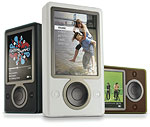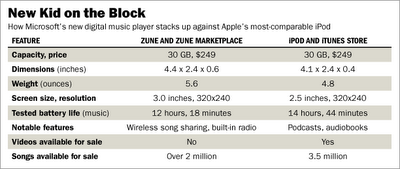Player Could Lure Converts, But It Makes Compromises
And Is Missing Some Features
By WALTER S. MOSSBERG
And Is Missing Some Features
By WALTER S. MOSSBERG
Next week, Microsoft Corp. will launch the most serious challenge ever mounted to Apple Computer's iPod and iTunes juggernaut in digital music. The software giant is introducing a portable player called the Zune, an online music store called Zune Marketplace and a new music software program called Zune that links the two. It plans to put plenty of marketing muscle behind Zune, and promises to expand and refine this new product line in coming years.
This isn't Microsoft's first effort to stop the iPod, but it's the first for which the software giant is adopting Apple's own business and design model -- where one company makes and controls the hardware, software and online component, and tightly integrates them. The Zune is produced by Microsoft's Xbox group, which builds game consoles on that same end-to-end principle.
In its first incarnation, the Zune comes in only one version, a big, chunky $249 model that can hold 30 gigabytes of music, videos and photos. I've been testing the Zune for the past couple of weeks and comparing it with the most similar of Apple's six iPod models -- the smaller of the two full-size iPods, which also holds 30 gigabytes and also costs $249.
Zune has several nice features the iPod lacks: a larger screen, the ability to exchange songs with other Zunes wirelessly and a built-in FM radio. It solves the worst problem that plagued earlier Microsoft-based music players -- frequent failures to synchronize properly music and videos between the players and personal computers. Synchronization on the Zune is smooth and sure.
Also, the Zune player and software have a very good user interface, different from, but in some cases easier to use than, the iPod's. While it lacks the famous iPod scroll wheel, instead using a common four-way navigation pad, I found song lists easy to navigate on the Zune. It has only a few buttons and is quite intuitive to use. To my ears, it sounded as good as the iPod.
Walt Mossberg says Zune, the upcoming MP3 player from Microsoft, has some attractive features but overall doesn't outshine Apple's iPod.
But, this first Zune has too many compromises and missing features to be as good a choice as the iPod for most users. The hardware feels rushed and incomplete. It is 60% larger and 17% heavier than the comparable iPod. It has much worse battery life for music than the iPod or than Microsoft claims -- at least two hours less than the iPod's, in my tests. Despite the larger screen, many album covers look worse than they do on the iPod. And you can't share music libraries between computers like you can with iTunes.
Zune's online store offers far fewer songs, just over two million, compared with 3.5 million for the iTunes store. In fact, as of this writing, songs from one of the big labels, Universal, were missing from Zune Marketplace, though Microsoft says it is confident it will have all the major labels when it launches Zune on Tuesday. Also, despite the player's capability, Zune Marketplace offers none of the TV shows, movies or music videos that iTunes does, and has no audiobooks or podcasts.
Even worse, to buy even a single 99-cent song from the Zune store, you have to purchase blocks of "points" from Microsoft, in increments of at least $5. You can't just click and have the 99 cents deducted from a credit card, as you can with iTunes. You must first add points to your account, then buy songs with these points. So, even if you are buying only one song, you have to allow Microsoft, one of the world's richest companies, to hold on to at least $4.01 of your money until you buy another. And the point system is deceptive. Songs are priced at 79 points, which some people might think means 79 cents. But 79 points actually cost 99 cents.
Unlike iTunes, Zune offers subscription plans, where you can get an unlimited numbers of songs for $15 a month. However, Microsoft is de-emphasizing this option and mostly positioning Zune Marketplace as a source of individually purchased songs and albums.
Some consumers may well choose Zune for its big screen, which looks great with photos and videos, for its wireless song swapping, or for its FM-radio capability, which requires a $50 accessory on the iPod. Others may favor Zune because they are as tired of Apple's dominance in music as some folks are of Microsoft's dominance in computers.
But Zune has only around 100 accessories at launch, versus 3,000 or more for the iPod. If you have any iPod-specific accessories, they won't work on the Zune. Also, none of the songs you may have purchased from Apple will play on the Zune, unless you undertake a laborious conversion process. Apple is rumored to be working on an all-new iPod with a screen as large or larger than the Zune's.
Zune marks an unusual turn for Microsoft. The company is abandoning its favored business model, where it builds software platforms and then lets other companies make a wide variety of products that use that platform. Instead, Microsoft is building and totally controlling the whole chain associated with the product: the hardware, the software and the online music store. Songs sold on Zune Marketplace are intended to play only on the Zune, and Zune players won't be able to play copy-protected songs bought elsewhere, even at other online stores that use Microsoft music formats.
Microsoft was driven to this approach because its platform model, so successful with personal computers, has failed miserably in the music category. Apple has simply rolled over all the hardware companies and online stores that were built around Microsoft's previous music system, called "PlaysForSure."
Zune comes in three colors: black and white, like the comparable iPod, and brown, a daring color for a consumer-electronics device, but one that has become popular in the fashion world. Each model also has a second color on a translucent band around its edge; the brown one is trimmed in green.
Placing the Zune next to the 30-gigabyte iPod provides a strong contrast. The iPod is thin, sleek and elegant looking. The Zune looks big and blocky, sort of like a prototype for a gadget, rather than a finished product. It is longer, thicker and heavier than even the 80-gigabyte iPod, which has more than twice its capacity.
Zune was adapted from a much-praised but slight-selling music player, the Toshiba Gigabeat, in order to get it to market more quickly.
The word "Microsoft" never appears anywhere on the Zune, only the new Zune logo and a cheeky, "Hello from Seattle" in tiny type at the bottom of the back of the device. The Zune's tag line, evident immediately when you open the box, is "Welcome to the Social," a phrase meant to stress the device's wireless song-sharing feature, and to reach out to the Zune's target market, young music lovers who build social relationships around favorite songs and artists.
But the wireless music-sharing feature on the Zune is heavily compromised, in a way that is bound to annoy the very audience it is targeting. Each song sent to your Zune from another Zune can be played only three times and is available for playing for only three days. After that, it dies and can't be played again unless you buy it. Even if you play the song only halfway through, or for one minute, that counts as one of your three allowed plays. In fact, in my tests, a song I sent to my assistant's Zune expired after only two plays, one of which lasted just a few seconds. Microsoft attributed that to a bug that it said would be fixed.
The Zune's other big plus, the big screen, is similarly compromised. While it is three inches versus 2.5 inches for the iPod's screen, it uses the same resolution. That combination can make images coarser and grainier. In my tests, on photos and videos, this didn't matter much, and the Zune did a good job, even automatically switching into horizontal screen mode. But images of album covers often looked fuzzy, grainy and even distorted on the Zune when compared with how they looked on the iPod.
And for a product that's all about "the Social," Zune is curiously lacking a very popular iTunes feature -- the ability to view and to listen to another user's music library over a local network. This iTunes feature works in homes, office, college dorms, hotels, and other places, and it functions in mixed groups of Windows and Macintosh computers. But with the new Zune software, you can share your library only with Xbox game consoles, not other computers.
On the plus side, I really liked the interface on the Zune. In some modes, it allows you to do things with fewer clicks than the iPod does. For instance, if you are browsing through music, you don't have to go back a step to switch from, say, a list of artists to a list of albums. Those choices are arrayed at the top of the screen and can be selected with a sideways push of the navigation pad.
Also, the entire interface is more colorful and visually satisfying than the iPod's. Lists of albums are accompanied by thumbnails of their covers. Menus zoom in and out, and some are translucent. You can also select your own photo as the wallpaper or background for the device. But, unlike on the iPod, you can't customize the main menu or go to "Now Playing," or shuffle all songs with one click.
The Zune software also has a handsome look and feel. And it allows you to "guest synchronize" a Zune on another computer, something iTunes doesn't allow. You can load songs from someone else's library onto your Zune without wiping out your own library, though you can't then transfer those songs back to your own PC.
But battery life on the Zune was very disappointing. Microsoft claims 14 hours of music playback on a single charge with the wireless feature turned off -- the same as the comparable iPod -- and 13 hours with wireless turned on. But Microsoft bases these claims on strict and unnatural usage conditions, such as never increasing the default volume, playing only one album over and over, and keeping the backlight on for just one second.
I tested the Zune in more normal conditions, shuffling through hundreds of songs, adjusting the volume where needed, skipping or repeating songs occasionally and using a 30-second backlight. In my test, I got just 12 hours and 18 minutes of music playback, versus 14 hours and 44 minutes from an iPod under the same usage pattern. With the wireless turned on, battery life on the Zune was worse -- just 10 hours and 12 minutes, even though I didn't send or receive any songs.
Overall, the iPod and iTunes are still the champs. Still, I expect the Zune to attract some converts and to get better with time. And this kind of competition from a big company with deep pockets and lots of talent is good for consumers in the long run.







0 comments:
Post a Comment